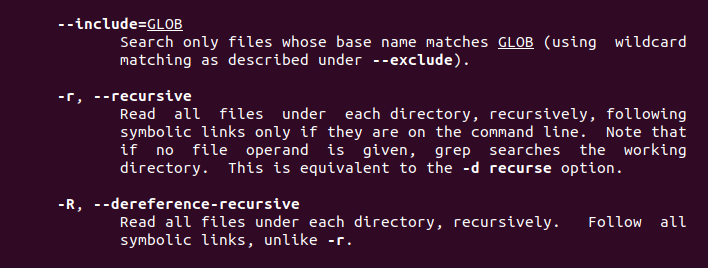

- Find in files grep recursive how to#
- Find in files grep recursive install#
- Find in files grep recursive update#
Whether you’re using the grep or find command, this technique allows you to search through large and complex file structures with ease, making it an ideal solution for complex search tasks. In conclusion, recursive search is a powerful technique for searching for strings in Linux command line.

The ‘-exec’ option allows you to execute a command on each file found by find, in this case the ‘grep’ command. Note that the ‘.’ at the beginning of the command tells find to start the search in the current directory, while the ‘-type f’ option restricts the search to files only. You can also use the find command to perform a recursive search for strings by using the ‘ -exec’ option in conjunction with the ‘grep’ command.įor example, to search for the string “example” in all files within the current directory and its subdirectories, you would use the following command: find. The find command allows you to search for files based on various criteria, including file name, type, and modification date. Recursive String Search With find CommandĪnother useful tool for recursive search is the find command. You can replace this with the path of any other directory you wish to search. Note that the ‘.’ at the end of the command tells grep to start the search in the current directory. To perform a recursive search with grep, you can use the ‘-r’ option, which tells grep to search for strings in all files and subdirectories within a directory.įor example, to search for the string “example” in all files within the current directory and its subdirectories, you would use the following command: grep -r "example". The grep command is a versatile tool that allows you to search for strings in files and directories, and it can be used in conjunction with other commands to perform more complex searches. The above command will search for the text ( ie., Search Text ) recursively in all sub-directories under the current working directory. Recursive String Search With grep Command

This command will search through all of the subdirectories of the current directory for the specified file. To find a file in Linux, the easiest way is to use the find command.

There are several ways to perform a recursive search in the Linux command line, and one of the most popular is the use of the ‘grep’ command. In recursive order, grep will search through all directories listed in the path using the recursive flag. With recursive search, you can search for strings in all files within a directory, regardless of their location or type, making it an ideal solution for complex search tasks. This technique can be particularly useful when you need to search through large and complex file structures, where a simple search may not be sufficient. These cron jobs need to be configured by root, since updatedb needs root privileges to traverse the whole filesystem.Recursive search is a process by which you search for a specific string in a directory and all its subdirectories.
Find in files grep recursive update#
To see the full list of locate's options, type:Īdditionally, you can configure locate to update its database on scheduled times via a cron job, so a sample cron which updates the database at 1 AM would look like: 0 1 * * * updatedb It will look through its database of files and quickly print out path names that match the pattern that you have typed. Or, to look for a filename or pattern from within the current directory, you can type: pwd | xargs -n 1 -I locate "filepattern"
Find in files grep recursive install#
If the install script doesn't do it for you, it can be done manually by typing sudo updatedbĪnd, to use it to look for some particular file, type: locate filename
Find in files grep recursive how to#
You should check the manual of your OS on how to install it, and once it's installed, it needs to initiate the database. One such common tool is locate or slocate/mlocate. However, there are more modern and faster tools than find, which are traversing your whole filesystem and indexing your files. Or if man pages aren't available at your system: find -help Grep includes a number of options that control its behavior. The items in square brackets are optional. To see the full list of options, type man find The syntax for the grep command is as follows: grep OPTIONS PATTERN FILE. With the find command, you can use wildcards, and various switches. It starts recursively traversing for filename or pattern from within the current directory where you are positioned. The default way to search for files recursively, and available in most cases is find.


 0 kommentar(er)
0 kommentar(er)
